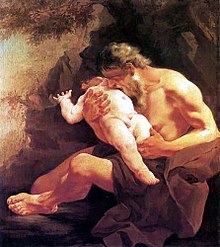Cronus is a Titan who used to be at the head of the pantheon in Greek mythology. His domain included everything, ranging from the underworld to the oceans, earth, and skies. He is the youngest son of Uranus and Gaia. Together with his mother, he plotted to overthrow his father. When he succeeded, he assumed his role as ruler of the universe.
Cronus himself was the Titan personification of time. When he slew his father it was prophesized that this cycle of patricide would repeat itself: Cronus himself would be overthrown by one of his own children as well. This is why he ate all of the children he conceived with Rhea. As we know, this did happen when Zeus finally took over. Cronus was locked away in Tartarus after that.

Cronus fathered many children on his sister Rhea. These children are the Olympians, who divided their father’s domains amongst themselves when they took over. He also fathered a child on the nymph Philyra. This is Chiron, the centaur. How did that happen? Cronus had assumed the shape of a stallion when he lay with his the nymph. Other centaurs are not born from Cronus, save perhaps Dolops and Aphreus.
